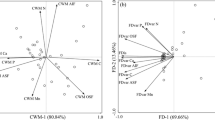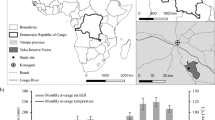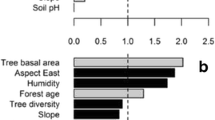Abstract
Investigating the relationship of biodiversity and ecosystem function in natural forests allows incorporation of established feedbacks between long-lived plants and soil processes. We studied forested stands in northern Arizona that vary in dominant species richness across small areas. We examined the effects of natural variation in dominant tree biodiversity on ecosystem parameters, particularly litter decomposition. We determined not only whether plant species decompose in mixture as predicted by their individual decomposition rates but also: (1) how particular species affect the decomposition rate of each other in mixture; and (2) whether litter decomposes more rapidly at its site of origin; i.e. is there a “home field advantage” to decomposition? Over a 2-year period, litter mixtures of functionally similar tree species decomposed more rapidly than expected from rates of the individual species alone. Mixtures of conifer species litter decomposed up to 50% faster than expected, with individual conifer members of those mixtures decomposing up to 85% faster than expected. In contrast, more functionally diverse mixtures of litter, which included a deciduous species, did not show synergistic effects during decomposition. We found no significant “home-field advantage” to decomposition. Our study is the first to demonstrate that litter mixtures from more closely related plant species give rise to the most synergistic effects of biodiversity on litter dynamics, indicating that more taxonomically and functionally diverse plant assemblages do not always drive greater emergent effects on ecosystem function.



Similar content being viewed by others
References
Balser TC, Firestone MK (2005) Linking microbial community composition and soil processes in a California annual grassland and mixed-conifer forest. Biogeochemistry 75:395–415
Balser TC, Kinzig AP, Firestone MK (2002) Linking soil microbial and ecosystem functioning. In: AP Kinzig, SW Pacala, D Tilman (eds) The Functional Consequences of Biodiversity: Empirical Progress and Theoretical Extensions. Princeton University Press, Princeton, NJ
Berg B, Staaf H (1980) Decomposition rate and chemical changes of Scots pine needle litter. II. Influence of chemical composition. In: T Persson (ed) Structure and function of northern coniferous forests. An ecosystem study. Ecol Bull, Stockholm 33, pp 163–178
Blair JM, Parmelee RW, Beare MH (1990) Decay rates, nitrogen fluxes, and decomposer communities of single- and mixed-species foliar litter. Ecology 71:1976–1985
Bottomley PJ, Yarwood RR, Kageyama SA, Waterstripe KE, Williams MA, Cromack K Jr, Myrold DD (2006) Responses of soil bacterial and fungal communities to reciprocal transfers of soil between adjacent coniferous forest and meadow vegetation in the Cascade Mountains of Oregon. Plant Soil 289:35–45
Chapman K, Whittaker JB, Heal OW (1988) Metabolic and faunal activity in litters of tree mixtures compared with pure stands. Agr Ecosyst Environ 24:33–40
Chapman SK, Langley JA, Hart SC, Koch GW (2006) Plants actively control nitrogen cycling: uncorking the microbial bottleneck. New Phytol 169:27–34
Finzi AC, Canham CD (1998) Non-additive effects of litter mixtures on net N mineralization in a southern New England forest. For Ecol Manag 105:129–136
Gartner TB, Cardon ZG (2004) Decomposition dynamics in mixed-species leaf litter. Oikos 104:230–246
Gholz HO, Wedin DA, Smitherman SM, Harmon ME, Parton WJ (2000) Long term dynamics of pine and hardwood litter in contrasting environments: toward a global model of decomposition. Glob Chang Biol 6:751–765
Hattenschwiler S, Gasser P (2005) Soil animals alter plant litter diversity effects on decomposition. Proc Natl Acad Sci-Biol 102:1519–1524
Hattenschwiler SH, Tiunov A, Scheu S (2005) Biodiversity and litter decomposition in terrestrial ecosystems. Annu Rev Ecol Syst 36:191–218
Hector A, Schmid B, Beierkuhnlein C, Caldeira MC, Diemer M, Dimitrakopoulos PG, Finn JA, Freitas H, Giller PS, Good J, Harris R, Högberg P, Huss-Danell K, Joshi J, Jumpponen A, Körner C, Leadley PW, Loreau M, Minns A, Mulder CPH, O’Donovan G, Otway SJ, Pereira JS, Prinz A, Read DJ, Scherer-Lorenzen M, Schulze E-D, Siamantziouras A-SD, Spehn EM, Terry AC, Troumbis AY, Woodward FI, Yachi S, Lawton JH (1999) Plant diversity and productivity experiments in European grasslands. Science 286:1123–1127
Hector A, Beale AJ, Minns A, Otway SJ, Lawton JH (2000) Consequences of the reduction of plant diversity for litter decomposition: effects through litter quality and microenvironment. Oikos 90:357–371
Hobbie SE (1992) Effects of plant species on nutrient cycling. Trends Ecol Evol 7:336–339
Hobbie SE, Nadelhoffer KJ, Högberg P (2002) A synthesis: the role of nutrients as constraints on carbon balances in boreal and arctic regions. Plant Soil 242:163–170
Hooper DU (1998) The role of complementarity and competition in ecosystem responses to variation in plant diversity. Ecology 79:704–719
Hooper DU, Vitousek PM (1997) The effects of plant composition and diversity on ecosystem processes. Science 277:1302–1305
Hooper DU, Chapin FS, Ewel JJ, Hector A, Inchausti P, Lavorel S, Lawton JH, Lodge DM, Loreau M, Naeem S, Schmid B, Setala H, Symstad AJ, Vandermeer L, Wardle DA (2005) Effects of biodiversity on ecosystem functioning: a consensus of current knowledge. Ecol Monogr 75:3–35
Iiyama K, Wallis AFA (1990) Determination of lignin in herbaceous plants by an improved acetyl bromide procedure. J Sci Food Agric 51:145–161
Klemmendson JO (1992) Decomposition and nutrient release from mixtures of Gambel oak and ponderosa pine leaf litter. For Ecol Manag 47:349–361
Knops JMH, Wedin D, Tilman D (2001) Biodiversity and decomposition in experimental grassland ecosystems. Oecologia 126:429–433
Loreau M (2000) Biodiversity and ecosystem functioning: recent theoretical advances. Oikos 91:3–17
Loreau M, Naeem S, Inchausti P, Grime JP, Hector A, Hooper DU, Huston MA, Faffaelli D, Schmid B, Tilman D, Wardle DA (2001) Biodiversity and ecosystem functioning: current knowledge and future challenges. Science 294:804–808
Naeem S, Li S (1997) Biodiversity enhances ecosystem reliability. Nature 390:507–509
Naeem S, Thompson SP, Lawton JH, Woodfin RM (1995) Biodiversity and ecosystem functioning: empirical evidence from experimental microcosms. Philos Trans R Soc B 347:249–262
Rustad LE (1994) Element dynamics along a decay continuum in a red spruce ecosystem in Maine, USA. Ecology 75:867–879
Salamanca EF, Kaneko N, Katagirl S (1998) Effects of leaf litter mixtures on the decomposition of Quercus serrata and Pinus densiflora using field and laboratory microscosm methods. Ecol Eng 10:53–73
Schweitzer JA, Bailey JK, Hart SC, Whitham TG (2005) Nonadditive effects of mixing cottonwood genotypes on litter decomposition and nutrient dynamics. Ecology 86:2834–2840
Tilman D, Wedin D, Knops J (1996) Productivity and sustainability influenced by biodiversity in grassland ecosystems. Nature 379:718–720
Wardle DA, Bonner KI, Nicholson KS (1997) Biodiversity and plant litter: experimental evidence which does not support the view that enhanced species richness improves ecosystem function. Oikos 79:247–258
Acknowledgements
We wish to thank Candy Feller, Kitty Gehring, Steve Hart, Bruce Hungate, Adam Langley, Greg Newman, Jen Schweitzer, Maribeth Watwood, Joe Bailey, and Tom Whitham for their advice on this study and manuscript. Further, Steve Hart generously provided lab facilities and advice.
Author information
Authors and Affiliations
Corresponding author
Additional information
Responsible Editor: Alfonso Escudero.
Rights and permissions
About this article
Cite this article
Chapman, S.K., Koch, G.W. What type of diversity yields synergy during mixed litter decomposition in a natural forest ecosystem?. Plant Soil 299, 153–162 (2007). https://doi.org/10.1007/s11104-007-9372-8
Received:
Accepted:
Published:
Issue Date:
DOI: https://doi.org/10.1007/s11104-007-9372-8




